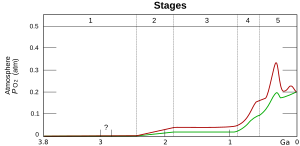Great Oxygenation Event facts for kids
The Great Oxygenation Event (GOE) was a super important time when lots of oxygen first appeared in Earth's atmosphere. This amazing change happened because tiny living things called cyanobacteria started making oxygen through a process called photosynthesis. It wasn't a quick event; it took a very long time, from about 3 billion years ago until about 1 billion years ago.
Even before the GOE, cyanobacteria were making oxygen. But this oxygen didn't build up in the air. Why? Because Earth's oceans had tons of dissolved iron. This iron would grab onto the oxygen, turning into iron oxide (which is like rust!). This created huge layers of banded iron rock that we can still see today. Once most of the iron in the oceans had rusted, there was nothing left to soak up the new oxygen. That's when free oxygen finally started to build up in the atmosphere. This was the Great Oxygenation Event!

This new oxygen was a big problem for most of the living things on Earth back then. Many early life forms were anaerobic, meaning they didn't need oxygen and it was actually toxic to them! As cyanobacteria made more and more oxygen, they changed the world for other tiny creatures. Since these other creatures couldn't handle oxygen, many of them probably became extinct.
Another huge effect of the new oxygen was on a gas called methane. Methane is a strong greenhouse gas, which means it helps keep the Earth warm. When oxygen appeared, it reacted with the methane and removed it from the atmosphere. This caused the Earth to cool down a lot, leading to a very long ice age called the Huronian glaciation. Since then, oxygen has been a super important part of our atmosphere.
When Did This Happen?
Scientists have found clues that tiny living things started making oxygen a very long time ago, maybe 3,500 million years ago (mya). These early organisms were prokaryotes, which are simple cells without a nucleus. Later, more complex cells called eukaryotes also made oxygen.
The oxygen they made at first was quickly used up by things like the "mass rusting" of iron. Oxygen only started to stay in the atmosphere in small amounts about 50 million years before the GOE really began. If nothing was using up the oxygen, it would build up super fast! Today, with all our plants making oxygen, we could fill the atmosphere to its current levels in only about 2,000 years.
Here's a quick timeline of how oxygen built up:
- 3,500 mya (Archaean eon): Cyanobacteria in structures called stromatolites started producing oxygen.
- Oxygen uses up iron: This oxygen caused huge deposits of iron to form as iron oxides in banded iron formations.
- Around 2,400 mya (Palaeoproterozoic era): Free oxygen began to escape into the atmosphere, but most of it was absorbed by land surfaces.
- Around 850 mya (Neoproterozoic era): Oxygen finally started to build up in the atmosphere. It kept increasing during the Palaeozoic era to the levels we have today.
Images for kids
See also
 In Spanish: Gran Oxidación para niños
In Spanish: Gran Oxidación para niños


